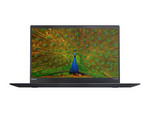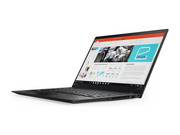Lenovo ThinkPad X1 Carbon 20HR006SUS
Specifications

Pricecompare
Average of 1 scores (from 2 reviews)
Reviews for the Lenovo ThinkPad X1 Carbon 20HR006SUS
Source: Ubergizmo English
 Archive.org version
Archive.org versionOn Lenovo’s site, The ThinkPad X1 starts at ~$1400 and can go to ~$2100 when “fully-loaded” (i7 7600U, 16GB, 1TB SSD). This is not cheap, but if you are looking at a laptop with the capabilities mentioned above, you will quickly realize that there aren’t a lot of competitors around.
Single Review, online available, Long, Date: 10/25/2017
Rating: Total score: 90%
Source: Hot Hardware
 Archive.org version
Archive.org versionCouple that great performance with one of the best laptop keyboards in the business, a gorgeous 14-inch WQHD OLED panel, a few nice chassis refinements, and better battery life and you have a HotHardware Editor's Choice product. Starting at $1682, but listing for $2429 as tested with its OLED display, faster CPU, 512GB SSD, and 16GB of RAM, it's not cheap but still is priced competitively to other premium offerings that don't have the OLED options. You can also find some pretty good promos out there right now on the machine; we found our test config on Amazon for a lot less. Regardless, congrats to Lenovo for making one of our current favorite ultrabook platforms even better.
Single Review, online available, Very Long, Date: 10/13/2017
Comment
Series: The Lenovo ThinkPad X1 Carbon 2017 is considered to be the most expensive and well recognized portable business notebook Lenovo has to offer and probably rightfully so since Lenovo acquired IBM’s PC division. What does this year’s X1 carbon has to offer in comparison to its competitor? It is powered by an Intel Core i7-7500U, up to 16 GB of soldered RAM, a super-fast 512 GB NVMe SSD, and a 14-inch IPS FHD panel. As the 7th Gen T4xx series has started to somewhat blur the difference between the X1 and the T4xx lineup, Lenovo practically had to go back to the drawing board to set it apart again starting with its chassis design. In terms of material choice, the X1 Carbon still uses a composite magnesium alloy for the base body with a matte rubbery feeling. This allows the X1 Carbon to maintain an extremely rigid, sturdy and rugged design. Unless you are intentionally applying a lot of pressure, the most you are going to be able to flex is the keyboard. However, in daily use this would never happen. The lid is made of a composite carbon fiber reinforced plastic, which might not be much of a comparison to the base chassis. However, it should be noted that you would still need a lot of force to intentionally warp or even damage it. Overall the chassis has really be well designed to meet its challenges. In terms of IO the X1 Carbon is well equipped with two USB type C Gen 2 connectors with Thunderbolt support, two full sized USB 3.0 type-A ports, a full sized HDMI video out, a mini Ethernet port,a microSD card reader and of course a headphone jack. When compared to other notebooks the only gripe is that the microSD card reader is a little hard to access without a SIM tool.
Naturally, as this is a business orientated notebook it also includes security features such as an integrated TPM 2.0 chip, a fingerprint reader and the usual Kensington lock. The only security feature missing here is a SmartCard reader which shouldn’t really be an issue since most of the common security features of a business notebook are already included. It should be noted that an optional IR camera can also be chosen, but it seems Lenovo has not started offering it yet. While the notebook is commonly shipped with your standard power adapter, Lenovo also offers a dock which is almost too commonly marketed with the Think lineup of notebooks. The optional docks are the USB C station dock and the newer Thunderbolt 3 station dock, with the latter being more feature-rich, but bulky in return. Moving over to the user inputs it is quite normal to say that the AccuType keyboard types like a wonder as in most Think series notebooks. However, the mechanics of this keyboard has been improved, while the previous generation of the keyboard felt a little shallow, the new improved version feels a bit deeper when it comes to key travel. This puts the X1 Carbon’s keyboard firmly at 1st place among most slim notebooks. As in most Think series notebooks, the signature track point and touchpad are a wonder to use. The glass touchpad remains nice to glide fingers on and is as accurate and precise as can be. One major point to emphasize here is that touchpad and click buttons remain separate, which should be the way, not the touchpad/clickpad combo nonsense most manufacturers are rolling out these days just to save costs. As for the trackpoint, the only honorable mention that can be done is it does its job as it was designed to.
As for the display, Lenovo actually offers two choices, the default FHD resolution panel with an option to choose the WQHD panel depending on the users need. Last on the list is the battery life. It is not surprising that X1 Carbon scored high. It achieved a battery lasting about 8 hours and 16 minutes on Wi-Fi and a whopping 11 hours and 9 minutes on video playback. The new 2017 X1 Carbon truly is a remarkable piece of hardware and is clearly well built with a focus on mobility.
Hands-on article by Jagadisa Rajarathnam
Intel HD Graphics 620: Integrated GPU (GT2) found on some Kaby-Lake CPU models (15 W ULV series).
Modern games should be playable with these graphics cards at low settings and resolutions. Casual gamers may be happy with these cards.
» Further information can be found in our Comparison of Mobile Graphics Cards and the corresponding Benchmark List.
i7-7600U: Kaby-Lake based SoC with two CPU cores clocked at 2.8 to 3.9 GHz, HyperThreading and manufactured with an improved 14nm process. Integrates a HD Graphics 620 clocked at 300 - 1150 MHz and is manufactured in an improved 14nm process.» Further information can be found in our Comparison of Mobile Processsors.
14.00":
There are hardly any tablets in this display size range anymore. For subnotebooks, on the other hand, it is the standard format.
The advantage of subnotebooks is that the entire laptop can be small and therefore easily portable. The smaller display also has the advantage of requiring less power, which further improves battery life and thus mobility. The disadvantage is that reading texts is more strenuous on the eyes. High resolutions are more likely to be found in standard laptops.
» To find out how fine a display is, see our DPI List.Lenovo: Lenovo ("Le" from English legend, novo (Latin) for new) was founded in 1984 as a Chinese computer trading company. As of 2004, the company was the largest laptop manufacturer in China and, after acquiring IBM's PC division in 2005, the fourth largest in the world. In addition to desktops and notebooks, the company manufactures monitors, projectors, servers, etc, and specializes in developing, manufacturing and marketing consumer electronics, personal computers, software, enterprise solutions and related services.
In 2016, the company ranked first in the world in computer sales. It still held it in 2023 with about 23% global market share. Important product lines are Thinkpad, Legion and Ideapad.
In 2011, it acquired a majority stake in Medion AG, a European computer hardware manufacturer. In 2014, Motorola Mobility was purchased, which gave Lenovo a boost in the smartphone market.
90%: There are not very many models that are rated better. Most of the assessments are in percentage ranges below that. The tested product is not considered perfect, but the sources give a clear purchase recommendation.
» Further information can be found in our Notebook Purchase Guide.


 Deutsch
Deutsch English
English Español
Español Français
Français Italiano
Italiano Nederlands
Nederlands Polski
Polski Português
Português Русский
Русский Türkçe
Türkçe Svenska
Svenska Chinese
Chinese Magyar
Magyar